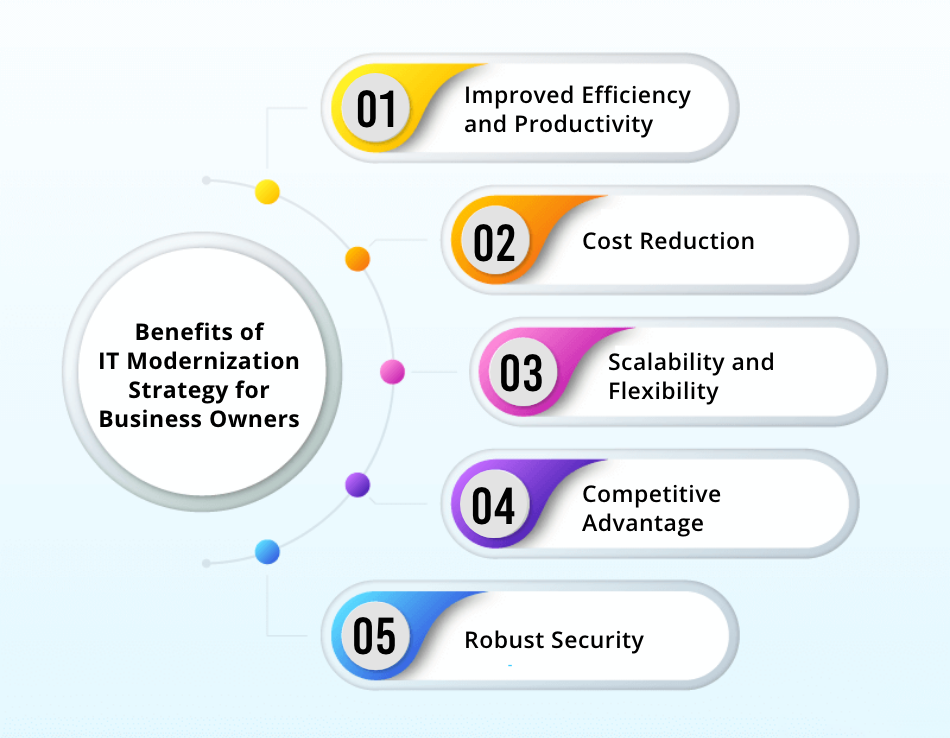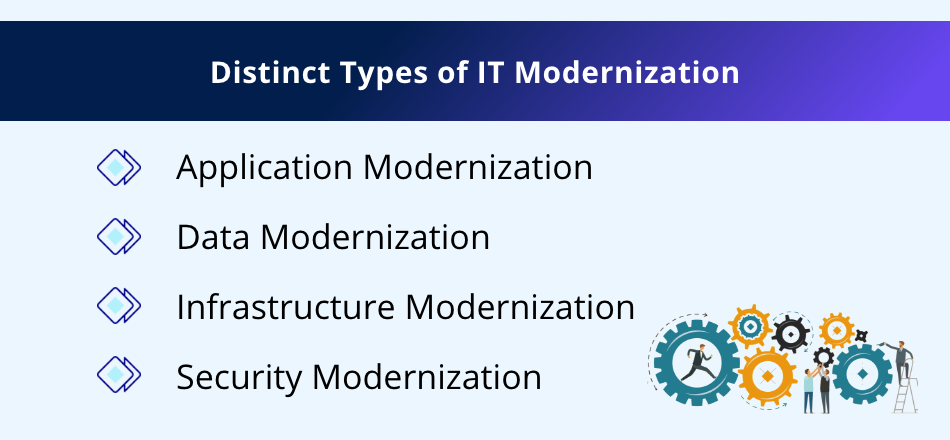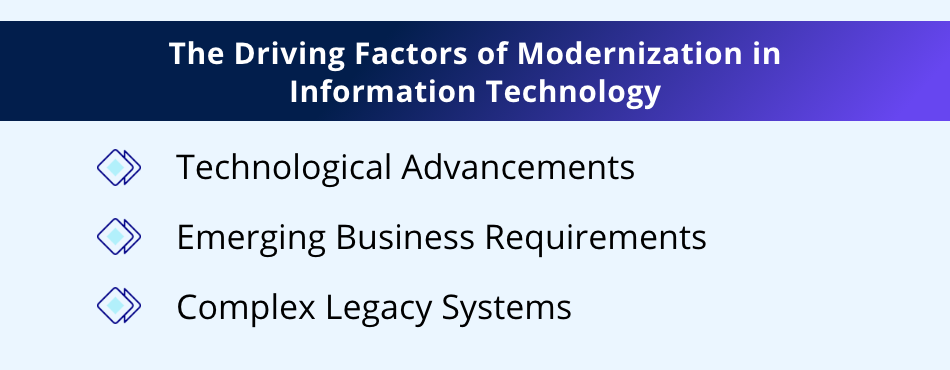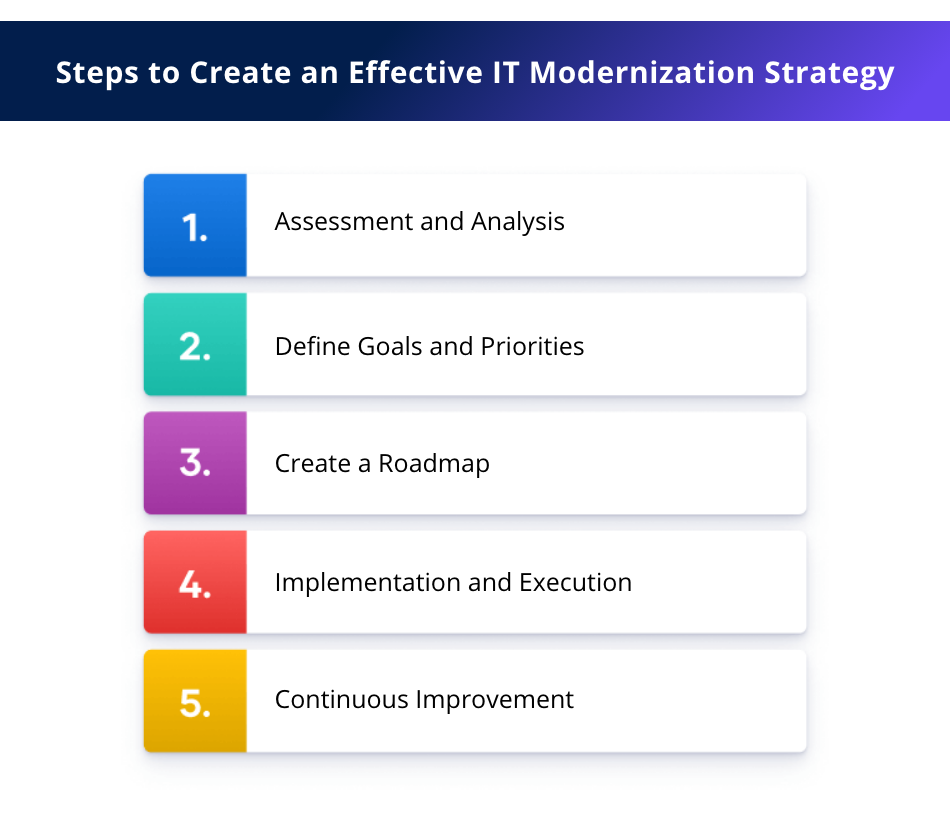A successful IT modernization strategy enables your organization to be more agile, secure, scalable, innovative, and cost-effective.
Updated 9 April 2024

CEO at Appventurez
In the ever-evolving world of technological advancement, the need to modernize IT systems has never been more crucial. An effective IT modernization strategy can help you outline your company’s approach to upgrading and transforming the information technology structure.
A technology modernization strategy enables organizations to streamline processes, automate repetitive tasks, and eliminate inefficiencies. By leveraging business modernization technologies, like cloud app development services, AI business solutions, and automation, businesses can improve agility and respond rapidly to changing market dynamics and customer demands.
If used thoughtfully, IT modernization strategies can empower your business to be faster, more efficient, and stay competitive. Now, when it comes to creating an IT modernization roadmap, ensure proper brainstorming and planning to achieve your end goals.
A successful mobile app growth strategy can help you increase the user base by maximizing the potential of the mobile app, ensuring it meets the end goals and generates higher revenue.
In this blog, we will walk you through the basic concept of digital modernization strategy including the top IT modernization examples, its different types, processes used to build an IT modernization strategy, and many more.
An effective IT modernization strategy refers to the process of updating and upgrading the organization’s information technology infrastructure, systems, processes, and practices. It leverages advanced technology services to improve efficiency, enhance security, and meet the evolving needs of the business.
Software gets outdated in no time, and that is why, embracing information technology modernization strategies can help you in providing more contemporary, agile, and scalable solutions.
The integration of future trends in the IT modernization strategy, like edge computing, the democratization of IT, hybrid IT environments, or cybersecurity is expected to revolutionize the digital landscape of IT modernization services in the coming years.
For instance, utilizing edge computing can help you process the data closer during its execution in smart devices or sensors. It ensures a seamless data flow between edge devices and cloud environments. On the other hand, IT democratization will promote a more user-friendly digital innovation with the help of low-code and no-code tools.
Following is a list of some key reasons why entrepreneurs from different industries want to bring modernization of technology into the game.

IT modernization strategy involves upgrading systems, processes, and infrastructure to leverage the latest tech modernization. It helps streamline workflows, automate repetitive tasks, and enhance overall efficiency, thereby boosting productivity.
IT modernization of technology often involves consolidating hardware, optimizing software licenses, and moving to cloud-based solutions. As a result, it reduces the app maintenance cost and eliminates the need for expensive hardware upgrades.
An IT modernization strategy is designed to be more scalable and flexible, enabling businesses to easily adapt to changing market conditions and scale their operations up or down as needed without interruptions.
Businesses that embrace a software modernization strategy can gain a competitive edge by staying ahead of the curve and leveraging modern technology to innovate faster, follow new market trends, and deliver high-end products and services compared to competitors.
Legal IT systems are more vulnerable to cyber threats because of outdated security measures. Leveraging a high-end IT modernization strategy allows businesses to implement state-of-the-art security protocols and tools for better data security from cyberattacks.
The IT modernization strategy aims to enhance the operational efficiency of the business to stay competitive and meet the ever-changing demands of the customer. There are four significant types of IT modernization with different approaches.

Let’s read about them one by one:
As the term explains, application modernization updates and improves the existing software apps to make them more agile, scalable, and secure. Here, the development team migrates the legacy applications into the updated or modern platforms, revamping the codes to offer excellent performance. The goal of application modernization is to increase the flexibility and innovation in digital solutions.
Another significant type of IT modernization is the transformation of existing data from on-premise systems to cloud-based data warehouse development. It optimizes a large set of datasets into more accessible and meaningful data insights. Leveraging the data modernization approach helps in finding out the important data, its usage, and how to make the most of it. As a result, data modernization will help you gain a competitive advantage.
While application modernization focuses on improving the frontend, IT infrastructure modernization aims at improving physical and virtual infrastructure systems. It enhances the technological components running in the backend by replacing the outdated hardware with the latest and updated equipment. IT infrastructure offers numerous benefits, including improvement in system performance, better resource efficiency, and enhanced mobile app security.
Last but not least is security modernization, which focuses on strengthening the organization’s cybersecurity to ensure business continuity. It mitigates emerging threats and complies with regulatory requirements. This approach includes the implementation of advanced threat detection and prevention systems, ensuring compliance with data protection regulations, like GDPR or CCPA.
The IT modernization strategy is a combination of cutting-edge technologies, ever-changing business needs, and global trends.
Here are some key factors of modernization involved in information technology (IT):

Technologies keep on upgrading with time, making it one of the primary driving factors of IT modernization strategy. Advanced technologies, like cloud computing, AI, IoT software development services, and data analytics fuel the need for modernization.
As a result, businesses seek to leverage these technological advancements to stay competitive. With the help of these technologies, businesses can easily streamline their work processes, increase productivity, and enhance efficiency.
Businesses evolve with changing market dynamics, and so do their requirement, this is when, flexibility, scalability, and agility come in to meet the ever-changing requirements. An effective IT modernization strategy ensures that businesses can manage multiple opportunities, handle the workload, and adapt to market changes.
Moreover, customer expectations increase with time, and matching to their level or delivering a seamless user experience is essential. That being said, IT modernization strategy has a significant role when it comes to evolving business requirements.
Some organizations still access the legacy systems because according to them, keeping pace with the latest technology is tricky. However, this should not be the case as these systems are prone to unavoidable challenges, like impacting productivity, posing security risks, being expensive, and more.
Therefore, utilizing an IT modernization strategy becomes imperative because it improves or replaces the older versions, enabling business owners to benefit from modern IT solutions.
Following is a list of key strategies you must know while adopting a network modernization strategy:
IT modernization strategy vs digital transformation is often used correspondingly with the integration of advanced technologies. Both strategies enable the organization to stay competitive, adapt to customer requirements, and accordingly achieve end goals.
According to Statista, the global application modernization tools market will reach the size of $36.86 billion by 2027. The need for digital transformation is going to drive the demand for application modernization tools.
However, both – IT modernization vs digital transformation have key differences.
Let’s explore:
| Features | IT Modernization | Digital Transformation |
|---|---|---|
| Explanation | Updates the organization’s IT infrastructure, practices, and systems as per the latest technologies. | An approach that transforms business processes and customer experience using technology. |
| Key Factors | Technological advancements and complex legacy systems | Industry trends and evolving customer expectations |
| Scope | Enhances productivity, efficiency, and scalability | Gains competitive advantage, drives innovation, and agility |
| End Results | Improved IT operations | Better customer experience |
| Example | Adopting cloud computing and improving security | Integrating IoT solutions and well-informed decisions |
| Timeframe | Typically shorter-term | Between 12 to 18 months |
Creating a successful and effective IT modernization strategy requires careful planning and execution to ensure that the organization is meeting future trends.

Here are five key steps to guide you through the process:
The first and foremost step involved in creating an effective IT modernization strategy is evaluating the latest IT infrastructure, systems, applications, and processes. You must identify areas that are obsolete, inefficient, or do not match your business needs.
After this, analyze your business objectives and future demands by considering various factors, like scalability, security, compliance, and user experience. Secondly, collect the input from key stakeholders, like IT staff, department heads, and especially end users, to determine their expectations.
Once you are done with assessment and analysis, it’s time to define your business goals and objectives to plan out a successful IT modernization strategy. Ensure to align your goals with the company’s overall strategic objectives.
Prioritize the areas that require immediate attention or offer the most significant potential for improvement. Also, make sure to consider factors such as impact on business operations, return on investment, and risk mitigation.
With the help of professional mobile app development services, you can create a detailed roadmap outlining the steps and milestones required to achieve your modernization goals. Break down the process into manageable phases, each with its timeline, deliverables, and resource requirements.
Identify the technologies, tools, and methodologies that will support your efforts in executing a successful IT modernization strategy. This may include cloud computing, automation, containerization, DevOps practices, and emerging technologies like AI and machine learning development services.
Execute your modernization plan according to the roadmap, ensuring that all stakeholders are informed and involved throughout the process. Implement changes in a phased approach, starting with low-risk, high-impact initiatives before tackling more complex projects.
Monitor progress closely, track key performance indicators (KPIs), and adjust your approach as needed to address any challenges or roadblocks that arise.
Creating an IT modernization strategy is an ongoing process that requires continuous monitoring, evaluation, and adaptation to keep pace with evolving technology trends and business needs.
Foster collaboration between IT and business teams to drive innovation and identify opportunities for improvement. Regularly review and update your IT modernization strategy to ensure that it remains aligned with your organization’s goals and priorities.
The benefits of an effective IT modernization strategy are manifold, providing flexibility, security, and increased productivity. From technological advancements to evolving business requirements, an IT modernization strategy can help your organization strive for transformative change.
For successful execution of your IT modernization strategy, get help from an expert like Appventurez. In the ever-evolving digital landscape, the company’s professional team will help you have a solid strategy to stand out among the competition and captivate your target audience.
Apart from creating an effective IT modernization strategy, we provide other services as well, like Android app development services, custom iOS application development, or cross platform development services.
So, consult our experts today and get a successful IT modernization strategy for your business.
Q. What are the different types of IT modernization strategies?
There are four major types of IT modernization strategies – application modernization, data modernization, infrastructure modernization, and security modernization.
Q. Which is the best example of modernization?
One of the successful examples of modernization in information technology is the migration from existing on-premise servers to cloud computing platforms.
Q. Why creating an IT modernization strategy is imperative for businesses?
Business owners opt for IT modernization strategies to stay competitive, improve operational efficiency, and meet the ever-changing demands of customers.


Elevate your journey and empower your choices with our insightful guidance.

CEO at Appventurez
Ajay Kumar has 15+ years of experience in entrepreneurship, project management, and team handling. He has technical expertise in software development and database management. He currently directs the company’s day-to-day functioning and administration.
You’re just one step away from turning your idea into a global product.
Everything begins with a simple conversation.